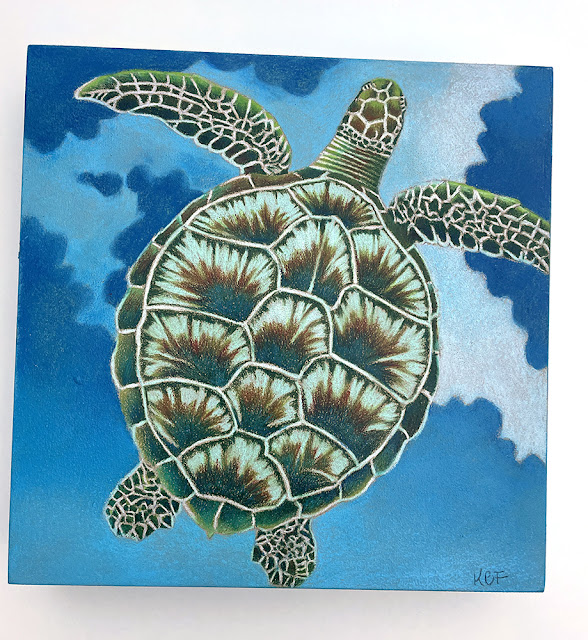This is a class project I taught with 3 students and I would like to teach it in more classes. This was kind of a "warm up" for me, I haven't taught this method in quite a while.
This first turtle drawing is mine as I want to show the progression of work. As a surface we used 8x8" cradled DaVinci Pro Medium Texured Gesso Panels from Jerry's Artarama art supply company. I coated the panels with Art Spectrum Liquid Colourfix pastel primer which gave the panels a very textured sanded surface. I chose a neutral background color, it will end up being covered with colored pencil but will show through the colored pencil in areas. You can draw directly on the primer with colored pencil.
I pressed hard with the colored pencils to fill in the sanded texture. You'll see as I'm working the background how textured this surface can be. To burnish the pencil into the shell of the turtle I used Prismacolor Colorless Blender Pencil. You can find these blender pencils at most art or craft stores.
To smooth out the textured background, I brushed Gamblin Company Gamsol odorless mineral spirits onto the layers of colored pencil. The mineral spirits will dissolve the pencil and allow it to flow like paint.
I sprayed Krylon UV Resistant Clear coating over the drawing. Then painted the sides of the panel with acrylic paint in a blue that would compliment the drawing. The entire piece will be varnished with Krylon Kamar Varnish .
These three following images are student work. Two chose the turtle design and the third liked the tomatoes on the vine. Below, the student who created this turtle chose to change colors to her own palette and paint around the turtle in acrylic. She also added a few "splashes" of acrylic to the turtle for interest. These two turtle drawings were done in Prismacolor Premier Colored Pencils.
This student used Faber Castell Polychromos pencils with Prismacolor Pencils. The Polychromos are oil based and have a harder point so they help push the pencil into the grooves of the surface.









No comments:
Post a Comment